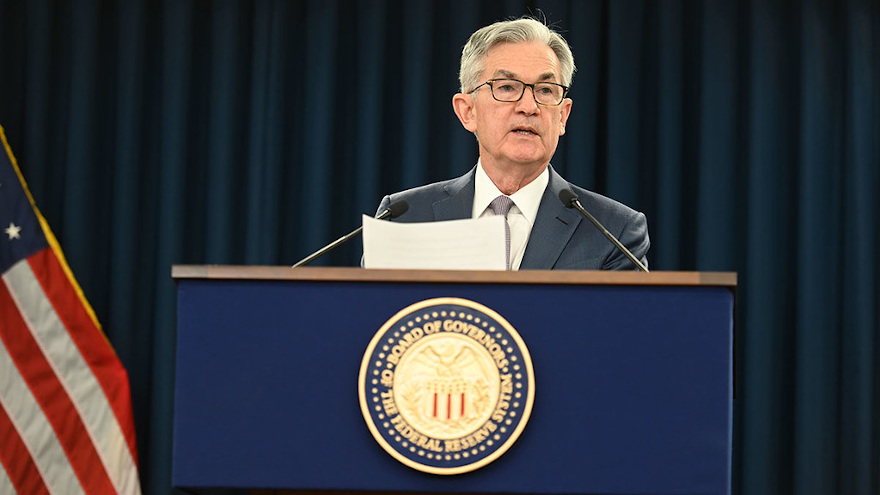UPDATED: Impact surprise Fed rate cut could leave on auto financing

Federal Reserve chairman Jerome Powell announced on Tuesday that policymakers cut the target range for the federal funds rate by 50 basis points to 1.00% to 1.25%. Photo courtesy of the Federal Reserve.
The Federal Reserve sensed the U.S. economy is becoming ill stemming from the COVID-19 coronavirus outbreak, so policymakers made the surprise move on Tuesday by cutting the target range for the federal funds rate by 50 basis points to 1.00% to 1.25%.
Experts at Cox Automotive and TrueCar reacted to the first Fed action outside of regular meetings of the Federal Open Market Committee (FOMC) since the end of 2008 and the financial crisis. Cox Automotive shared its assessment on its blog, Commentary & Voices, mentioning how auto-finance rates have held “relatively high in recent months.” Cox Automotive agreed with other analysts, noting the average APR at 5.69% in February, down from 5.75% in January.
“According to our Industry Insights team, today’s surprise move by the Federal Reserve will not lower interest rates for most car buyers. In fact, the stock market has not responded well to the cut — at the time this is being posted — so vehicle demand could actually be hurt by declining wealth and lower consumer sentiment, which typically follows stock market correction,” Cox Automotive wrote on Tuesday afternoon in this post.
“Bottom line: Stock market volatility, COVID-19 concerns and even the political landscape in this election year are all wild cards that weigh on consumer confidence and may well become a drag on auto sales,” the company’s experts went on to say.
The analyst team at TrueCar weighed in on the development in a message sent to SubPrime Auto Finance News on Wednesday morning.
“By cutting the interest rates by half a percentage point, consumers can potentially save from five to eight dollars per month on their payments, which can save a total of $400-$600 during the duration of the auto loan,” said Nick Woolard, director of OEM and affinity partner analytics at TrueCar.
“However, lowering the rates does not get at the heart of the issue,” Woolard continued. “The coronavirus can still affect overall consumer behavior and, even with lower interest rates, consumer confidence can still negatively impact the automotive industry.”
Federal Reserve chairman Jerome Powell explained why the FOMC unanimously approved Tuesday’s action just two weeks ahead of its regularly scheduled meeting to consider rate adjustments.
“My colleagues and I took this action to help the U.S. economy keep strong in the face of new risks to the economic outlook,” Powell began during his prepared remarks. “The fundamentals of the U.S. economy remain strong. The unemployment rate has been near half-century lows for well more than a year, the pace of job gains has been solid, and wages have been rising. These strong labor market conditions have underpinned solid household spending, which has been the key driver of economic growth over the past year. At the time of our FOMC meeting in January, prospects for continued economic growth remained favorable, and we judged that monetary policy was well positioned to support that outlook.
“Since then, the spread of the coronavirus has brought new challenges and risks,” he continued. “The virus has afflicted many communities around the world, and our thoughts and prayers go out to those who have been harmed. The outbreak has also disrupted economic activity in many countries and has prompted significant movements in financial markets. The virus and the measures that are being taken to contain it will surely weigh on economic activity, both here and abroad, for some time. We are beginning to see the effects on the tourism and travel industries, and we are hearing concerns from industries that rely on global supply chains. The magnitude and persistence of the overall effects on the economy, however, remain highly uncertain, and the situation remains a fluid one.”
Curt Long, chief economist and vice president of research at the National Association of Federally-Insured Credit Unions (NAFCU), offered this reaction, looking ahead as to what the Fed’s next move might be.
“While a rate cut doesn’t do much to solve the economic and financial consequences of COVID-19, it at least reassures markets that the Fed is ready to offer whatever support it can,” Long said. “And it refocuses policymakers on fiscal responses, which are more likely to have a real impact.
“For its part, the Fed will be hoping that markets remain relatively stable while more data comes in. But with the virus spreading and plenty more room for mitigation response, the risks are still heavily weighted to the downside, and more rate cuts are likely to follow,” he added.
Chief economist Robert Dye and the team at Comerica Bank also considered what the Fed might do next, emphasizing that policymakers work in the monetary world, not healthcare.
“The Fed rate cut comes as the U.S. government and the U.S. economy adapts to the threat of the coronavirus,” Dye began. “It is important to note that there is nothing the Fed can do to change the trajectory of the global coronavirus outbreak. It cannot alter the disruption to global supply chains and the demand destruction due to the temporary cessation of business production and personal travel. However, the Fed can ‘foam the runway’ and do what it can to support and encourage economic activity in the U.S. and foster a quick recovery from the dampening impact of the coronavirus outbreak.
“We believe that there is significant downside risk to the U.S economy from the global coronavirus outbreak,” he continued. “We expect the U.S. economy to slow meaningfully through the first half of 2020. Therefore, the Federal Reserve may decide to cut the fed funds rate further in the months ahead.”

 View The Latest Edition
View The Latest Edition

